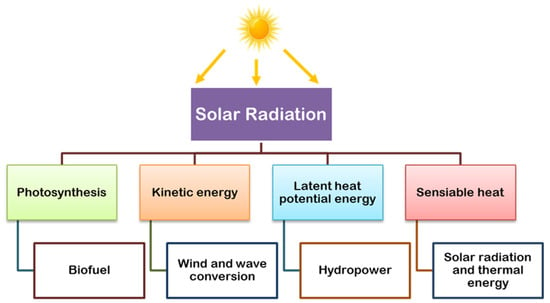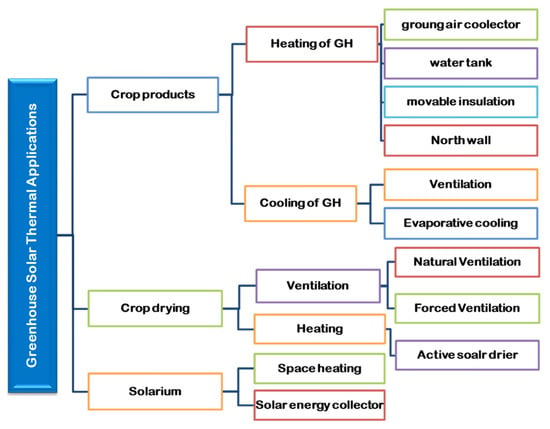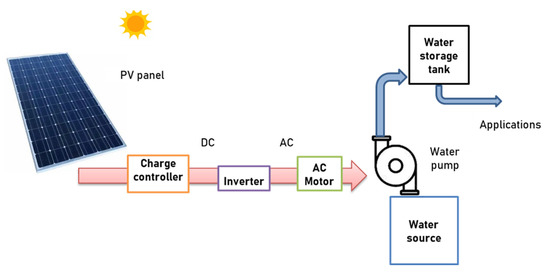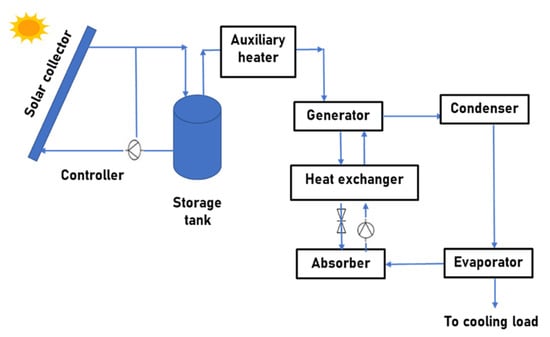You're using an outdated browser. Please upgrade to a modern browser for the best experience.
Please note this is a comparison between Version 1 by Sheikh Khaleduzzaman Shah and Version 2 by Rita Xu.
The use of solar thermal systems (STSs) has reached a significant edge. The increasing research on developing an alternative power supply for limiting fossil fuel usage and climate change are the driving forces of STSs. STSs’ applications, including PV/T or “photovoltaic/thermal” systems, zero-energy buildings, greenhouse solar thermal applications, solar thermal for pumping water, solar thermal refrigerators, solar chimneys, water desalination, and solar collectors, along with the benefits and challenges of these applications.
- solar thermal systems
- renewable energy
- climate change
1. Introduction
Recently, energy, environment, and economic development have been exceedingly intertwined. Appropriately utilising available energy requires carefully managing employed technologies and assessing social impacts. The sustainable development of countries’ economic growth mainly depends on good planning and the responsible consumption of fossil fuels and renewable energy resources, i.e., solar, hydro, biomass, and wind energy. Solar energy is available everywhere, even in remote locations, making it an adequate substitute for fossil fuels. The sun dissipates a massive quantity of radiation energy to its surroundings by about 174*1015 W at the layer of the upper atmosphere of Earth. Almost 51% of the total incoming solar energy reaches the land and oceans. Solar energy from the sun can be categorised as light or photons and heat with electromagnetic waves. Fundamentally, the sun is the source of all renewable energy sources, as presented in Figure 1.

Figure 1. Solar radiation as the main source of renewable energies on Earth.
Demand for cleaner energy sources has grown in recent decades. Most countries have drawn up long-term plans based on renewable sources. Governments worldwide are beginning to use renewable energy resources and reduce their reliance on conventional fossil fuels [1][2][1,2]. In 2021, renewable energy technologies garnered 70% of all energy investment, yet worldwide CO2 emissions rose by 1.5 billion tonnes [3][4][3,4]. The European Union (EU2030)’s Framework for Climate and Energy states that emissions must be reduced, with a binding target of at least 40% below 1990 levels before 2030 [5]. Various renewable energy technologies, primarily solar ones, can be used to meet these objectives. Solar devices, in particular photovoltaic (PV) panels [6], solar thermal collectors [5], or photovoltaic/thermal (PVT) collectors [6], are easily integrated into a variety of industries. Future predictions indicate that solar energy will soon surpass fossil fuels. Due to the development of the economy and industry, solar energy generation is anticipated to reach 48% by 2050 [7][8][7,8]. Solar energy is used for power generation using PV systems [9][10][9,10], heating air with solar air heaters [11][12][11,12], dry agricultural products using solar air dryers [12][13][12,13], providing drinking water using solar-powered desalination systems [14][15][14,15], cooking food using solar cookers [16], etc. Several types of research have been conducted to improve the performance of solar systems. Phase change material (PCM) and nano-enhanced PCMs [17][18][17,18], thermoelectric generators [19][20][19,20], nano-enhanced coatings [21], and nanofluids [22][23][22,23] are different methods for improving the performance of solar systems. The particular approaches employed are primarily determined by the unique features of the solar system and the opportunities that are available for improving performance or utilising additional system availability to produce other forms of energy. For instance, PCMs could be employed in solar thermal systems (STSs) to increase the module’s exit temperature [24]. Thermal or PVT collectors utilise nanofluids for a faster rate of heat transfer [25], and thermoelectric generators can be utilised to co-generate electricity and heat/cold from desalination units or solar PV [26].
Modelling and simulation are effective tools for deciding the best operating conditions of various processes, such as tracking the maximum power point of grid-connected solar PV panels [27][28][27,28]. Artificial intelligence is an attractive methodology with a lower limitation than physical and mathematical modelling [29]. Artificial intelligence is effectively used to improve the efficiency and performance of several processes [30][31][30,31], including hybrid renewable energy sources [32][33][32,33]. Artificial intelligence plays an important role in increasing STSs’ utilisation, including increasing their overall efficiency, cost minimisation, safety enhancement, scenarios to minimise environmental impacts, developing smart systems, optimising operations, and developing more accurate models of the different systems [8].
Recent advances in solar thermal systems (STSs) undoubtedly have a significant role in achieving the Sustainable Development Goals (SDGs) adopted by the UN in 2015 to be achieved in 2030. In addition to core contributions to SDG 7, which focuses on access to affordable, reliable, sustainable, and modern energy for all, and SDG 13, on urgent action to combat climate change, STSs can also make critical contributions to the other 15 SDGs, including helping to alleviate poverty, fight hunger, increase access to healthcare, education, and clean water, and protecting life on land and in water. It is essential to analyse the role of STSs in achieving the 17 SDGs.
2. STSs or “Solar Thermal Systems”
Due to growing energy consumption, on the one hand, and the negative environmental effect of different fossil fuels, countries around the world are depending on alternative energy resources as a feasible and suitable choice in different applications, such as industry, agriculture, and domestic usage [34][40]. Solar energy is one of the cleanest sources of alternative energy. The study of the applications of solar systems in diverse areas of engineering technology is introduced to emphasise the necessity of using solar energy, with a special focus on thermal sources whenever possible, such as zero-energy buildings, greenhouse solar thermal applications, solar thermal energy for pumping water, solar thermal refrigerators, solar chimneys, water desalination, solar collectors, photovoltaic/thermal (PV/T) systems, etc.2.1. Zero-Energy Buildings
Buildings considerably influence environmental issues, as they consume nearly one-third of the world’s energy [35][41]. The main challenge that must be comprehensively evaluated is energy consumption from an economic perspective, considering its influence on the environment. Zero-energy structure principles were first reported in 1976, and an investigation of ZEB or “zero-energy building” started around 2000 [36][37][42,43]. Among countries, communities, and regions, the criteria of ZEBs differ from one place to another [38][44]. The Sustainable Building Institute Europe listed ten challenges hindering the establishment of zero-energy structures from becoming relevant and realistic. ZEBs were first developed in Denmark, utilising solar energy for household applications in cold seasons. On the other hand, the BIPV or “building-integrated photovoltaic” system is a practical, promising, and innovative application to achieve green buildings, thus the term BIPVT or “building-integrated photovoltaic thermal” [39][45]. Photovoltaics are designed to be integrated with a building as an alternative to conventional constituents to supply electricity. Rapid advances have been achieved for enhancing the energy output of BIPVT designed for facades, rooftops, and windows. In addition, their thermal performance mechanisms, benefits, applications, barriers, and challenges have been introduced [9][40][9,46].2.2. Greenhouse Solar Thermal Application
The use of greenhouse structures allows for the introduction of more favourable conditions, which are necessary for the rapid growth of crops at any time of the year. Solar energy is utilised to increase the yield of various agricultural products based on the greenhouse system, such as the drying of agricultural products and crop production [41][47]. Specifically, solar energy is utilised to increase the yield of agricultural products grown in greenhouses. A more comprehensive categorisation of solar thermal applications for greenhouses is presented in Figure 2. After the solar radiation has been absorbed by the plant being grown inside the greenhouse, it is then expelled into the air around it in the form of water vapour. This process occurs after the solar radiation has passed over the greenhouse cover. Radiation can be transferred to the air inside by the floor, or it can be transferred to the ground below by heat conduction [42][48]. Therefore, the ambient air in the greenhouse is heated, and then various thermal losses are induced via the various pores. There are a few parameters that have a significant impact on the system [43][44][49,50]. These include the plant area, plant mass, the area of an aquifer-coupled cavity flow heat exchanger system, and the flow rate of circulating air.
Figure 2. Broader classification of greenhouse solar thermal applications.
2.3. Solar Thermal for Pumping Water
Traditional diesel-powered pumps are commonly implemented for irrigation purposes. However, due to increased oil prices, harmful emissions due to burning, short lifetimes, and high maintenance costs have forced scientists to develop alternative routes. The solar-powered water pump has a number of advantages, for instance, reliability, being more economical, a low maintenance cost, dependence on renewable solar energy, a lack of noise, eco-friendliness, with no effect on environmental pollution, and a long life span compared to diesel-powered water pumps [45][51]. The generalised representation of a solar-powered water pump is shown in Figure 3. The solar power system is comprised of photovoltaic (PV) panels with or without an appropriate tracking system for improving electrical efficiency. The developed electrical energy is in DC, whereas the pump mostly requires AC, so an inverter is employed to convert the output energy to AC. A water pump or a water submersible pump is installed on the ground level [46][47][52,53].
Figure 3. Continuous flow of a solar-powered water pump system.
2.4. Solar Thermal Refrigerators
Recently, the development of refrigeration technologies has been pursued to reduce energy consumption and avoid peak electrical demand without sustaining the desired standard of comfort conditions [48][54]. Solar refrigeration technology has the advantage of avoiding the negative impacts of conventional refrigeration systems, and the requirements of the cold often coincide with solar radiation availability. As such, researchers’ primary area of attention has been the advancement of solar refrigeration technologies. In STSs, heat is actually used more frequently than solar energy’s electricity. The flat-plate and evacuated tube collector is the most prevalent kind of solar thermal system. Current systems for generating the refrigeration effect using solar thermal energy are essentially based on the sorption mechanism: the gas/solid adsorption process and the gas/liquid absorption process [49][50][55,56]. The mechanism of the adsorption process depends on the separation of a substance from one phase and its accumulation onto the surface of a solid surface; the process efficiency depends on the affinity of the adsorbent towards a specific adsorbate as well as the specific surface area of the adsorbent. In contrast to the absorption process, the working substance is transferred from a specific phase to another to form a solution [51][57]. A schematic diagram of a solar-powered absorption refrigeration system is presented in Figure 4.
Figure 4. A schematic diagram of a solar-powered absorption refrigeration system.
2.5. Solar Chimney
The use of energy in buildings covers many reasons, such as heating and cooling for a comfortable lifestyle, transportation in tall structures, lighting for many appliances, and other services. This is a crucial issue. As shown in Figure 5, the solar chimney (SC) is primarily an open-loop natural circulation system that can be utilised for electricity generation or natural ventilation (NV) [52][58]. The SC that produces electricity contains a sizable area of solar collectors that can efficiently absorb solar radiation [53][54][59,60]. The buoyant force that affects passive air circulation is produced in part by the height of the solar chimney. The solar chimney is additionally used in air-conditioning systems for passive cooling in natural ventilation systems of various buildings [55][56][61,62]. Natural ventilation relates to various SDGs or “Sustainable Development Goals” under the umbrella of the UN Agenda 2030, including climate action, thermal comfort, wellbeing, energy efficiency, and clean energy [57][58][63,64]. Conventional air-conditioning systems consume approximately 15% of the world’s total electricity [59][65]. Otherwise, solar and natural ventilation is recommended to provide cooling needs, with a 10% and 15% reduction in power and yearly usage, respectively [60][66].
